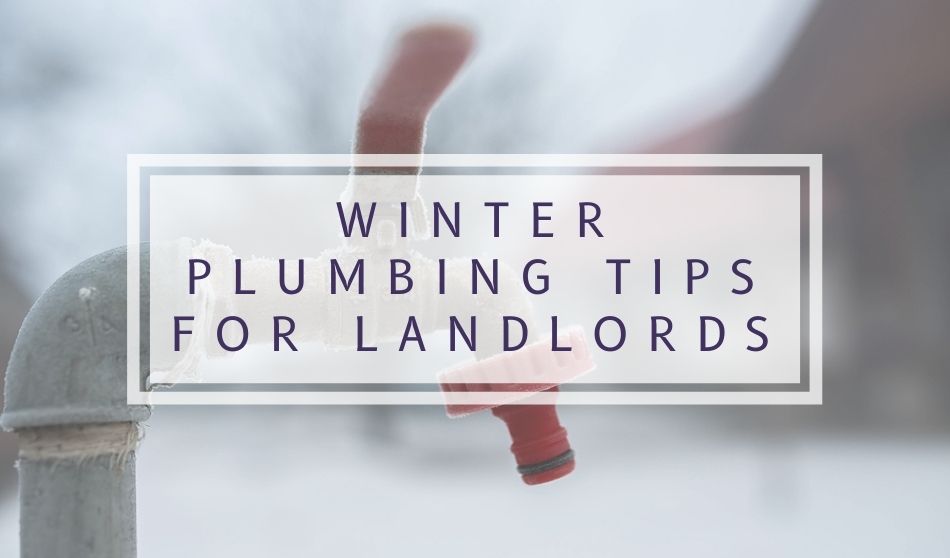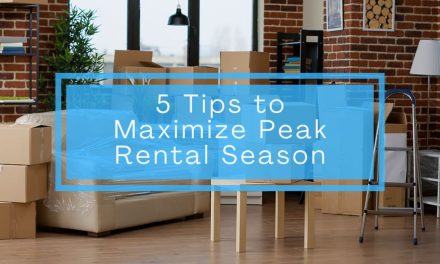
When temperatures drop in cold and snowy weather regions, winter plumbing takes the top spot as one of the most important maintenance tasks for your rental property. And thankfully, there are common-sense steps to “winterize” your property each season in order to prevent major plumbing issues and expensive repairs.
Top Cold Weather Plumbing Problems
Temperature fluctuation may be a regular part of changing seasons, but it can create a perfect storm of problems where your plumbing is concerned. Falling leaves and debris, extra cooking, and freezing temperatures are a recipe for common plumbing issues:
- Clogged drains
- Unattended leaks creating mayhem
- Increase of sediment and rust in the Water Heater
- Broken garbage disposals
- Frozen pipes and pipe bursts
Even for regions where snow and icy weather may be rarer, a cold wave could catch you and your renters off guard. Be prepared for common cold-weather plumbing problems. Informing and empowering your renters is a key step in protecting your rental property from damage and costly repairs.
Clogged Drain Prevention and Repair
The top causes of clogged drains haven’t changed much over time, and they often become problematic during winter holidays when more guests flow through homes, using the showers and sinks more regularly. Remember: hair, trash, soap, uncleared mineral deposits, and large food items will bring drains to a standstill.
Other specific don’ts for your drain include:
- Car fluids
- Coffee Grounds
- Eggshells
- “Flushable” cat litter
- “Flushable” wipes
- Grease
- Oils
- Paper towels
- Produce stickers
DIY Clearing Your Drain
If it’s too late, and the drain is already backed up, you can try a few quick methods. Eye and face mask protection are a smart move to avoid direct contact with bacteria, mold, chemicals and other waste products. Popular Do It Yourself options for drain clearing include:
- Home Recipe: Pot of boiling water down drain, ½ cup vinegar, ½ cup baking soda down drain, close drain cover for 15 minutes, open and pour a final pot of boiling water.
- Use Your Hands or Pliers – Remove the drain cover and often you’ll see and can remove the problem.
- Plastic Drain Clog Remover: Use this 24-inch, plastic, flexible barbed tool that easily grabs trash, hair, and food. Finish with a pot of boiling water down the drain.
Give Leaks Your Immediate Attention
If you’ve left a slow leak until the cold months, it’s time to jump on that repair right away. Not only do leaks waste the precious resource of water, but they will undoubtedly add to your utility bill. The main problem with leaks in winter weather is expansion in the pipes should the water freeze. When that happens, the leak grows into a bigger issue that could result in additional repair costs.
DIY Leak Fixes for Accessible Pipes
In many circumstances, a leaky pipe may require a plumber, especially for external piping or wall piping. However, if you’ve identified the pipe in an accessible area like under the sink, there are some quick methods that will provide a temporary solution.
Always start by turning off the water main, turning on the faucet to drain the pipes, and thoroughly drying the area. Then try these Do It Yourself steps to fix your leak:
- Replace the P-trap or other accessible pipe under the sink – make sure you have the right fit and double-check the alignment.
- If you’re using PVC and copper pipes, consider using a Pipe Clamp to cover the compromised portion of the pipe. These are widely available and easy to install, as long as you have the same size clamp as your pipe.
- Cover a hole with Epoxy Putty – this is a pretty good temporary fix. Just make sure you use protective gloves, and wait about 10 minutes after applying before turning on the water
Drain & Flush The Water Heater
Hard water inevitably leads to the buildup of sentiments like calcium and magnesium, which in time develops into rust. Remember, this is the water that will flow into your home for drinking, cooking, and cleaning. With the cold weather, you’ll want to make sure you fix this problem and provide safe and clean water for your household.
Realize that standard water heaters have a lifespan in the range of 7–12 years, depending on the level of maintenance given. Try this method below, but know that the sun may be setting on your water heater.
How To Drain the Water Heater
Put safety first as you deal with electricity, gas, and hot water. Then takes these routine steps to drain and flush the sentiment buildup from your water heater:
- Turn off electricity or gas source – follow the manufacturer instructions
- Turn off the water supply – This is the cold water valve to your water heater
- Turn on the hot water – Open a faucet and leave it on while draining the water heater
- Connect a hose and drain the water heater into buckets
- Flush cold water through the water heater again by opening the cold water valve
- Close the drain valve of the water heater
- Refill the water heater tank
- Turn on the electricity or gas source
Never want to deal with draining the water heater tank again? Consider a tankless hot water heater system, which provides endless hot water on demand.
Fix a Clogged Garbage Disposal
Winter holidays often bring along larger meals and more people eating them. Plumbers frequently get calls in winter to clear, repair or replace garbage disposals. Follow the same list of items to avoid as with other drains, and remember to avoid these additional items which regularly cause chaos for garbage disposals:
- Banana peels
- Chemicals like Drano – These can damage the disposal parts
- Fruit pits
- Paint
- Pasta
- Potato peels
- Rice and beans
- Seafood shells
DIY Garbage Disposal Repair
Try these Do It Yourself steps if it’s too late, and you’re dealing with a backed up or broken garbage disposal:
- Is there a brief humming sound coming from the disposal? If so, check the circuit which may have been tripped. If it’s still humming but not working properly, proceed to the steps below.
- Press the garbage disposal Reset button – typically on the bottom of the unit.
- Insert an Allen Key in the slot next to the reset button, turn it both back and forth to free any blockage until you feel the blades turning freely.
- Turn on the water and check that the sink is draining
Don’t be discouraged if you need to call a plumber on this one. Sometimes the grease and food backup is significant and may require a drain snake or similar.
Frozen Water Pipes – What to Do
Frozen pipes are a cold-weather plumbing issue that you do not want to encounter when the temperatures take a polar plunge. They can cause property damage – especially if they burst – and headaches for you and your renters. The American Red Cross notes that frozen pipe problems usually occur when pipes and water lines get exposed to extreme cold and lack of heating and insulation of both indoor and outdoor water lines. A good winter maintenance plan can be key in preventing this issue before it starts.
However, if you suspect a problem, check your pipes for a freezing issue by turning on a faucet. If water only trickles out, be sure to check other faucets throughout the property. A slow-flowing faucet is a key indicator that one or more pipes or areas have been affected by the cold weather.
Do It Yourself steps you can try to thaw frozen pipes:
- Warm the pipes up close with the help of a hairdryer, a heating pad, or towels soaked in hot water.
- Heat exposed pipes by turning on a space heater.
- Turn up the temperature on your thermostat to defrost frozen pipes in the walls and other unexposed locations.
- Keep the faucet open so the melting water flows to melt other areas of the pipe.
- DO NOT use any sort of open flame or gas-powered device!
- Don’t stop until your water flows at its full, usual pressure.
Steps to take to prevent frozen pipes in the future:
You and the tenants of your rental property can also live by these helpful tips to avoid frozen pipes:
- Make sure the water line entry area is warm and insulated.
- Open kitchen cabinet doors to allow heat to reach otherwise isolated pipes.
- Leave faucets running at a trickle to relieve pressure buildup and prevent frozen pipes.
- Consider asking your utility provider if it can offer a small billing adjustment for running your water to prevent pipes from freezing. It could save you and your renters money and trouble!)
- Consider a tankless water heater for an endless hot water supply as a way to avoid frozen pipes and keeping hot water flowing – without waiting for a tank to heat up the next batch.
Learn more about how to fix and prevent frozen pipes in this article: Steps to Take for a Burst or Frozen Pipe
Winter Plumbing Tasks for Every Landlord and Homeowner
Cold weather plumbing experts recommend the following measures be taken to avoid unexpected breakdowns that can cause cold, unhappy tenants.
- Know & instruct where the property’s main water valve is. This becomes very important in a plumbing emergency!
- Install insulation like foam sheaths on pipes located in unheated areas of your rental property to reduce heat loss.
- Check for damaged or bulging pipes that you may have missed last year. It could save you a burst pipe this year!
- Disconnect, drain, and turn off hoses and outdoor spigots. Turn off the water valve, open the faucet outside to drain the water, and turn on your water.
Additional Winter Plumbing Tips from Energy Experts
The US Department of Energy recognizes the potential for plumbing problems in cold weather and offers these added recommendations on preparing your home for winter weather:
- Require tenants to keep their thermostats above a certain temperature (like 65 degrees F) and leave taps dripping.
- Check items off a fall to-do list that includes installing rain barrels, removing leaves and other debris, and winterizing swimming pools.
- Drain water from swimming pools and sprinklers supply lines according to manufacturer guidelines and avoid putting antifreeze in them unless directed.
When To Call for Help
Many professional plumbers have seen it all. They are typically licensed and trained to deal with most winter plumbing issues and can get it done without a big mess or further property damage. Get them involved sooner than later, and get your property ready to withstand the next cold wave or winter storm.
This article was originally published in February 2021 and has since been updated.






When cleaning the drain, avoid using commercial drain cleaners. Off-the-shelf drain cleaners come with yet another hazard: they have the ability to corrode metal pipes. Using a powerful drain cleaner several times in a row has the potential to corrode an entire pipe system. This would require lengthy and costly repair work.
You are correct about the risks of using commercial drain cleaners. They can indeed corrode metal pipes, leading to significant damage and costly repairs. Instead, consider using safer alternatives like a mixture of baking soda and vinegar, or employing a drain snake to clear clogs. Regular maintenance, such as running hot water down the drains weekly, can also help prevent buildup without the use of harsh chemicals. For persistent issues, it’s best to consult a professional plumber to avoid further damage.
This WINTER PLUMBING TIPS is Really Helpful Every LANDLORDS Even know this , Thanks Robert Hoffmann to Share with us
nice blog its really helpful thanks for sharing this information
Thanks, glad you’re finding it helpful!